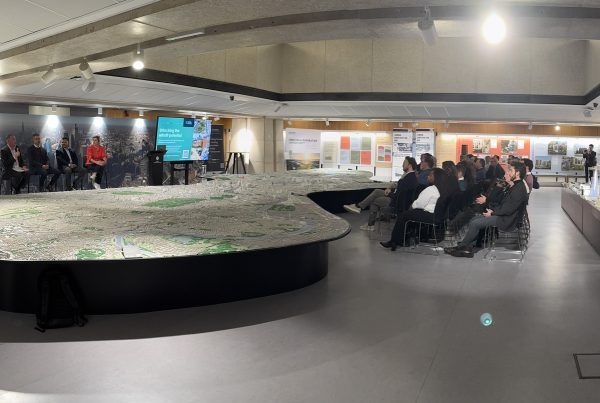
In an era when every industry is taking steps towards sustainability to help combat climate change, construction is one of the biggest impactors that can make a positive difference to the environment. In addition to the growing concerns about climate change, rising energy bills have also become a challenge and retrofitting existing buildings for energy efficiency has become a crucial strategy for reducing environmental impact, enhancing sustainability and minimising energy costs. By retrofitting buildings for energy efficiency, buildings are brought in line with modern and future regulations, property value is increased, and a huge contribution is made towards achieving carbon reduction targets.
Contributing to London’s £138.6bn construction sector, Thames Freeport plays a role in supporting sustainable development initiatives, including modern, affordable housing. With the UK aiming to retrofit over 5 million homes, Thames Freeport aligns with sustainability initiatives that promote long-term energy efficiency. Retrofitting is an environmentally friendly alternative to demolition, improving a building’s energy efficiency while reducing construction waste and emissions.
How does Retrofitting Improve Energy Efficiency?
Retrofitting enhances a building’s energy efficiency by reducing heat loss, optimizing energy consumption, and, in some cases, integrating renewable energy sources. Through key upgrades such as improved insulation, new windows and modern heating systems, heating is retained, and therefore, operational costs are a lot lower. Buildings can retain more heat during colder months and, when combined with passive cooling strategies such as shading and ventilation, stay cooler in warmer months, reducing the need for excessive heating or air conditioning.
Through the use of smart lighting and solar panels, energy consumption is significantly reduced. Smart lighting, when combined with LED technology and automated controls, ensures that output is limited and only used when necessary, further improving energy efficiency. Meanwhile, solar panels generate renewable electricity, reducing reliance on traditional energy sources and lowering electricity bills.
All these retrofitting upgrades contribute towards a higher energy performance which showcases energy efficiency. Buildings become more energy efficient, environmentally friendly and cost-effective, making them better suited to meet modern energy standards and climate goals.
What are the Benefits of Retrofitting Buildings for Energy Efficiency?
While there are many reasons to retrofit a building, enhancing energy efficiency is one of the most common and important. Improving the energy performance of a building has a range of benefits that are an advantage to the consumer, the community and the environment.
Global Impact
Buildings account for a significant portion of global energy consumption and carbon emissions, making the need for energy performance improvement incredibly important. Energy-efficient retrofits are a key solution to improving energy performance without the need for complete reconstruction. By introducing energy-saving infrastructure, including smart lighting, updated heating systems and renewable energy methods, older buildings can climb the ratings of energy efficiency. Retrofitting a building for improved energy efficiency ensures that buildings are easier to heat, retaining this heat for longer and reducing heating costs. Smart lighting through timers, motion sensors and even smart technology controls minimise energy consumption. Renewable energy is also a common way to improve energy efficiency, reducing environmental impact through generating energy, most commonly through solar panels. With current global goals to achieve net zero emissions by 2050, retrofitting buildings for energy efficiency plays a crucial role by reducing energy consumption and enabling a transition to low-carbon energy sources.
Savings on Operational Costs
Any building that operates with low energy efficiency runs the risk of incurring high energy costs. Older buildings are traditionally more difficult to heat, struggling to retain heat long-term and with energy prices continuing to rise, utility bills can become extremely significant. With an improved energy performance, buildings keep their heat longer, resulting in lower energy costs, which is a great financial saving for businesses and consumers. Smart lighting can also reduce energy consumption, while energy-saving bulbs also contribute towards reduced energy usage. These energy savings will also attract building tenants looking to benefit from lower energy bills.
Protection Against Rising Energy Costs
Energy costs continue to rise, and as resources become more scarce, this will become even more of a financial challenge. Retrofitting helps to future-proof buildings by ensuring predictable operational expenses as a defence against fluctuating energy prices. Solar panels can reduce operational expenses by generating electricity, especially when paired with storage solutions or favorable net metering policies. Many retrofitting projects follow a ‘fabric first’ approach, improving insulation and reducing heat loss before upgrading mechanical systems.
Increased Property Value
The market value of a building is increased with great energy efficiency. While many areas of retrofitting are an investment, the ROI is worthwhile with retained property value and higher resale prices. Green certification attracts eco-conscious buyers and buildings with enhanced energy performance, fetching a more significant price tag.
How to Retrofit Buildings for Energy Efficiency
Retrofitting ideally takes a whole-building approach, but staged retrofitting—where improvements are made incrementally—is often used to manage costs. Rather than upgrading individual components, which have minor boosts to energy efficiency, retrofitting looks at the ways the building would operate most efficiently and takes significant steps towards it.
Upgraded Insulation and Windows
Retrofitting traditionally takes a ‘fabric first’ approach to upgrade the energy efficiency of a building by improving the insulation. Excess energy consumption is commonly attributed to heat loss so by enhancing insulation and switching out single-pane windows to double-glazing, the easiest steps are taken towards improving the energy performance of a building.
Upgraded HVAC Systems
Upgrading HVAC (Heating, Ventilation and Air Conditioning) is the second step in retrofitting a building for energy efficiency. Replacing old boilers and heating systems with newer, more efficient models optimises energy use. Modern heating systems use less energy to operate and improve the energy efficiency of a building. Heat pumps efficiently transfer heat instead of producing it through combustion, significantly reducing energy consumption compared to traditional fossil fuel-based heating systems. Buildings can also take advantage of solar energy for heating systems, a game changer for retrofitting buildings to make them more energy efficient.
Smart Lightning
Efficient lighting through LED upgrades can cut electricity costs by up to 75% compared to traditional bulbs. LED lighting is a simple solution to improve energy efficiency, but there are also additional ways to cut costs. Smart technology has transformed the way that buildings can operate, and through timers, motion sensors, voice controls and apps, lighting can be optimised to conserve energy and only operate when required.
Renewable Energy
The final step in retrofitting is to make use of renewable energy with the ability to generate energy a significant method to improve energy efficiency. Most buildings with renewable energy use solar panels but more rural locations can also take advantage of wind turbines. With renewable energy systems in place, buildings become less reliant on other energy sources, therefore preserving scarce resources, reducing carbon emissions and minimising operational costs.
Retrofitting Buildings for Energy Efficiency
Retrofitting a building is the best way to improve energy efficiency without the need to demolish or reconstruct, which has higher consumption and emissions. By decreasing the energy demand, buildings can operate in a way that is more environmentally friendly, with savings passed onto building owners and tenants through lower utility bills and tax relief. Retrofitting is a great opportunity to future-proof buildings, bringing them not only up to date with current regulations and climate goals but also ensuring the building is prepared for energy efficiency long term.



